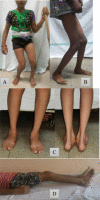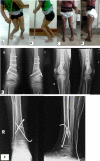Crouch Gait in Cerebral Palsy: Current Concepts Review
- PMID: 38009172
- PMCID: PMC10673808
- DOI: 10.1007/s43465-023-01002-5
Crouch Gait in Cerebral Palsy: Current Concepts Review
Abstract
Background and objective: Crouch gait is the most common pathological gait pattern in cerebral palsy and is commonly seen in patients with spastic diplegia. It is characterized by excessive knee flexion throughout the stance phase of gait cycle. The aim of this review is to discuss the current literature about CG for a more comprehensive understanding.
Methods: A literature review about various aspects of crouch gait in cerebral palsy was undertaken. This included its etiology and pathophysiology, biomechanics in crouch gait, natural history of untreated crouch gait, clinical and radiological evaluation and different modalities of available treatment.
Results: The etiology is multifactorial and the pathophysiology is poorly understood. This makes its management challenging, thereby leading to a variety of available treatment modalities. Inadvertent lengthening of muscle-tendon units is an important cause and can be avoided. A meticulous clinical and radiological evaluation of patients, supplemented by observational and instrumented gait analysis is mandatory in choosing correct treatment modality and improving the treatment outcome. Younger children can be managed satisfactorily by various non-operative methods and spasticity reduction measures. However, crouch gait in cerebral palsy has a progressive natural history and surgical interventions are needed frequently. The current literature supports combination of various soft tissue and bony procedures as a part of single event multilevel surgery. Growth modulation in the form of anterior distal femur hemiepiphysiodesis for correction of fixed flexion deformity of knee has shown encouraging results and can be an alternative in younger children with sufficient growth remaining.
Conclusions: In spite of extensive research in this field, the current understanding about crouch gait has many knowledge gaps. Further studies about the etiopathogenesis and biomechanics of crouch using instrumented gait analysis are suggested. Similarly, future research should focus on the long term outcomes of different treatment modalities through comparative trials.
Keywords: Cerebral palsy; Child; Crouch gait; Knee; Spastic diplegia.
© Indian Orthopaedics Association 2023. Springer Nature or its licensor (e.g. a society or other partner) holds exclusive rights to this article under a publishing agreement with the author(s) or other rightsholder(s); author self-archiving of the accepted manuscript version of this article is solely governed by the terms of such publishing agreement and applicable law.
Conflict of interest statement
Conflict of interestThe authors state that they have no conflict of interest, financial or otherwise, concerning the material or methods used in this study or the findings specified in this paper.
Figures






Similar articles
-
Correction of severe crouch gait in patients with spastic diplegia with use of multilevel orthopaedic surgery.J Bone Joint Surg Am. 2006 Dec;88(12):2653-64. doi: 10.2106/JBJS.E.00993. J Bone Joint Surg Am. 2006. PMID: 17142416
-
Distal Femoral Extension Osteotomy with 90° Pediatric Condylar Locking Compression Plate and Patellar Tendon Advancement for the Correction of Crouch Gait in Cerebral Palsy.Indian J Orthop. 2019 Jan-Feb;53(1):45-52. doi: 10.4103/ortho.IJOrtho_410_17. Indian J Orthop. 2019. PMID: 30905981 Free PMC article.
-
Multilevel orthopedic surgery for crouch gait in cerebral palsy: An evaluation using functional mobility and energy cost.Indian J Orthop. 2011 Jul;45(4):314-9. doi: 10.4103/0019-5413.82334. Indian J Orthop. 2011. PMID: 21772623 Free PMC article.
-
Does patella lowering as part of multilevel surgery improve knee kinematics in children with cerebral palsy and crouch gait? A meta-analysis of comparative studies.J Child Orthop. 2023 Dec 14;18(1):13-25. doi: 10.1177/18632521231217542. eCollection 2024 Feb. J Child Orthop. 2023. PMID: 38348440 Free PMC article. Review.
-
Evaluation and management of crouch gait.Curr Opin Pediatr. 2016 Feb;28(1):55-9. doi: 10.1097/MOP.0000000000000316. Curr Opin Pediatr. 2016. PMID: 26709688 Review.
Cited by
-
Influence of crouch angle on lower-extremity kinetic gait profile and walk distance in children with cerebral palsy: a cross-sectional study.BMC Biomed Eng. 2025 Jul 1;7(1):7. doi: 10.1186/s42490-025-00093-5. BMC Biomed Eng. 2025. PMID: 40588747 Free PMC article.
References
-
- Wren TA, Rethlefsen S, Kay RM. Prevalence of specific gait abnormalities in children with cerebral palsy: influence of cerebral palsy subtype, age, and previous surgery. Journal Of Pediatric Orthopaedics. 2005;25(1):79–83. - PubMed
-
- Sutherland DH, Davids JR. Common gait abnormalities of the knee in cerebral palsy. Clinical Orthopaedics and Related Research. 1993;288:139–147. - PubMed
Publication types
LinkOut - more resources
Full Text Sources
